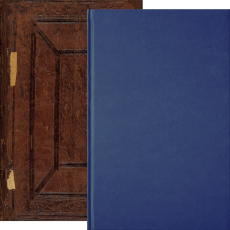Produktbeschreibung
Augsburg University Library Cod. Ⅰ.6.4º 2, facsimile & commentary by Christian Henry Tobler and Jessica Finley (translators), Dierk Hagedorn (transcriber), Michael Chidester (editor). With Articles by Michael Chidester, Jessica Finley, Elias Flatscher, Dierk Hagedorn, Marlene Hurst, Lucien Lee, Charles Lin, Oskar ter Mors, Reinier van Noort, Christian Henry Tobler, and Bartłomiej Walczak.
The Universitätsbibliothek Augsburg Cod.I.6.4º.2 is a German fencing manual of unknown authorship, so it's usually known as the Bauman Fight Book (after a name recorded in its covers) or Codex Wallerstein (after its 19th century home at Wallerstein Castle). In addition to our exact replica of the manuscript, we decided to release the scans from the facsimile as a normal book.
This manuscript consists of two distinct treatises, based on the art style and the handwriting; the first section likely dates to the 1470s, while the second is much older, from perhaps the 1420s. The label "Von Baumans" and the date 1549 appear inside the cover, leading Hils to speculate that an Augsburg mercenary named Michael Baumann owned the treatise. The first section seems to have been used by Albrecht Dürer as a reference for his own fencing treatise.
The Bauman Fechtbuch is interesting in that its teachings do not seem to fall clearly into the tradition of the grand master Johannes Liechtenauer. Part A, which treats long sword, messer, and dagger, and Part B, which treats grappling, are the first entries in a series of manuscripts known as the Augsburg group, which originate from that area and seem to document a local martial tradition. Part C, on the other hand, is the first entry in a complex of treatises known as pseudo-Gladiatoria due to its uncertain relationship to the Gladiatoria group (a tradition not dependent on Liechtenauer). Ps-Gladiatoria covers the same sorts of dueling as the Gladiatoria group and has some 16 plays in common, but the differences are too extensive to classify them as versions of the same treatise.
This is a two-volume set; these books can also be purchased separately at a small price increase. Volume 1 is a complete reproduction of the manuscript, using the same scans as our Bauman Fight Book facsimile (sometimes called Codex Wallerstein) but printed and bound in a conventional book.
Volume 2 is a commentary volume, including a complete transcription and translation as well as a wealth of research related to the history and context of the manuscript.In its pages, you will find a detailed description of the manuscript itself by Michael Chidester, a full transcription by Dierk Hagedorn and translation by Jessica Finley and Christian Henry Tobler, and articles from some of the leading scholars in the field of historical European martial arts studies that highlight various aspects of the manuscript and its history.
Finley and Tobler also introduce the contents of parts A and B in a paper that discusses the various teachings and explores relationships with the tradition of Johannes Liechtenauer. Bartłomiej Walczak discusses the dagger section and uses it as a lens through which to examine the origins and structure of the Augsburg tradition as a whole. Lucien Lee discusses the Messer fencing and proposes connections to other pre-Lecküchner texts. Elias Flatscher evaluates the wrestling teachings and compares them to modern wrestling traditions. Charles Lin and Marlene Hurst present a discussion of the historical context of the fighting teachings of parts A and B and some advice on training them in ways that reflect that context. Finally, Dierk Hagedorn shows connections between the illustrations in part C and Gladiatoria. An appendix contains an edition of another manuscript with similar artwork by Reinier van Noort and Oskar ter Mors.
Geb., Bd. I: 224 S. (ganzseitige Farbtafeln); Bd. II:, 265 S., zahr. Abb.


